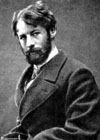 Baron Wilhelm von Gloeden, born in Mecklenburg (Northern Germany) in 1856,
went to Italy in 1878, hoping to cure his lung problem. He settled in
Taormina, a small seaport in Sicily, which he was to call his ‘heaven on
earth’. There he regained his health, quite likely also as a result of his
erotic fulfillment. From the early 1880s on he specialized in photographs of
nude boys in bucolic settings, becoming a pioneer of open air photography.
But it was not before 1895, when his stepfather lost his fortune and Gloeden
his allowance, that he turned professional, selling his photographs on a
large scale.
Baron Wilhelm von Gloeden, born in Mecklenburg (Northern Germany) in 1856,
went to Italy in 1878, hoping to cure his lung problem. He settled in
Taormina, a small seaport in Sicily, which he was to call his ‘heaven on
earth’. There he regained his health, quite likely also as a result of his
erotic fulfillment. From the early 1880s on he specialized in photographs of
nude boys in bucolic settings, becoming a pioneer of open air photography.
But it was not before 1895, when his stepfather lost his fortune and Gloeden
his allowance, that he turned professional, selling his photographs on a
large scale.Curiously enough, his trade was not underground, as one might imagine, considering the prudish and notably homophobic atmosphere of the time. Many of the pictures were published in major photographic magazines and also shown at public exhibitions, where they were awarded prizes, even in England. It is true that Gloeden not only did nudes, but also portraits, landscapes, genre pictures and so on. Though he apparently never photographed anything openly sexual, the erotic implications of his nude pictures seem to be clear enough to make it downright astonishing that anybody could see in them nothing but ‘ethnographic studies of young natives of the island of Sicily’, as one of the magazines put it at the time.
Moreover, this admirer of the Greeks was genuine in his enthusiasm for the people of his adopted country, the descendants of the citizens of the ancient Tauromenion, founded in 603 B.C. by Dionysos I, the Greek ruler of Syracuse – an origin that often seemed to be confirmed by the perfect beauty of the male youth, though sometimes covered in rags. Drawing on the widely esteemed traditions of classical antiquity, Gloeden presented his pictures as ‘illustrations of Homer and Theocritus’, which was a useful subterfuge and also the reason for the camp style of some of his pictures. On the other hand, that incongruity between the idealistic attempt to match the balanced repose of classical statues and the natural bodily reality of these young peasants, fishermen and shepherds can be especially charming. There are also pictures that are not meant to express a specific theme but show the dreamy state of vague expectation characteristic of adolescence, and these appear the most truthful and convincing.